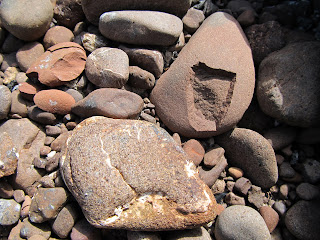The great thing about a 3-day weekend is how it gives you time to concoct a complex plan, get started, procrastinate, rush to take care of the chores you'd ignored before because the project seemed cooler, and finally make a little more headway on the project before collapsing in lumbar agony. That's why I am sitting on a heating pad with stacks of wood cut, yet unjoined, in the garage.
My ridiculous primate architecture is modern enough that the skeleton is no longer so adept at canopy cavorting, but in many aspects not much different than a Cambrian creature. The spine is fine supine in the ocean brine, but sucks for feet on concrete or bending over.
In Hawai`i, one option was to drink some `awa (a.k.a. kava in most of Polynesia, yangona in Fiji, or Piper methysticum in the priestly language of botanists), which relaxes the muscles and either alleviates pain or makes a guy forget it in the midst of kava conversation, which flows easily and abundantly. I've seen it called a narcotic time and again, but it just ain't so. I used to sit under the banyan tree at the community garden, having a few cups with the Rotumans, Fijians, and Tongans, spinning yarns and stringing stories. Tongue numbed and eventually legs too, but nothing like being drunk and much subtler than the western pharmacornucopia had trained me to withstand.
I grew a dozen or so plants in the cinder of Puowaina, adding years of leaves and compost before anything was harvested from black soil full of worms. Most were still going when I moved away from the islands, leaving them in good hands. The ones I dug were approved of by the garden crew, and my finest waka roots made it to Kona, to Nu`alolo, to Moloka`i Nui a Hina.
Anything left from that batch would be a decade or more old at this point, but it turns out that I had some other `awa in the freezer, sitting untouched for who knows how long. I know a guy who spent a little time in Fiji and a few people with Hawai`i connections, but nobody to sit with and socialize over a bowl of vintage root. So, I broke into it for the medicinal value tonight, and here I sit, obviously feeling well enough to remain in the chair and blather on. So now I know that yeah, kavalactones retain some effect even after years in a freezer. Enough so I can blather further on. And on.
And off. To way back when I was writing about blackberries, a couple of posts ago. That had to do with another type of drink: blackberry leaf tea. Specifically the local native known as the trailing blackberry (a.k.a. dewberry to people who are more mature than I am, or Rubus ursinus to the science Latinists). I had hoped to dry it under the sun yesterday, but the sun got wind of that, and hid behind the clouds, snickering audibly.
I'd also planned to cook up some tender shoots, but got waylaid by designing and starting to build something, and instead put off even stripping the leaves off the stalks til the after dinner sun-break today. The result is shown below, inside and away from dew, sending out aroma runners through the house, tendrils of citrus and banana peel wafting and tickling noses. I think it'll be good tea.































